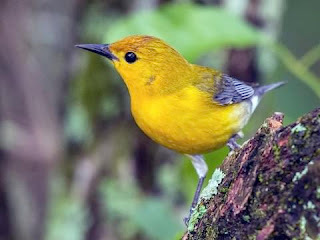 |
| Prothonotary Warbler is one of our focal bird species. Photo -- Creative Commons. |
Recently, our Club decided to roll up our collective sleeves and take on several related projects to benefit the birds we love. We are collaborating with the City of Ithaca and the Cornell Botanic Gardens on projects on two parcels at the south end of Cayuga Lake.
One parcel, Renwick Woods Wildlife Sanctuary adjacent to Stewart Park, exists today because our first Club President, Louis Agassiz Fuertes, worked tirelessly in 1913 to protect these seasonally flooded woods from development. Today, these woods are degraded by a combination of over-browsing by deer and a plethora of invasive, non-native plant species. This parcel is owned by the City of Ithaca.
 |
| Lighthouse Point Woods (a.k.a. Jetty Woods) is one of the parcels we are working in to improve habitat for migratory birds. Photo credit - Jody Enck. |
The second parcel, owned by the Cornell Botanic Gardens, is officially named Lighthouse Point Woods although many birders know it as Jetty Woods for the jetty that extends from its north end out into Cayuga Lake. If anything, the habitat in this parcel is even more degraded in terms of being less diverse than over in Renwick Woods. These two parcels are only about 150 meters apart at their closest points, and they are separated by Fall Creek and part of a public golf course.
We chose 3 focal bird species after doing some research using eBird and other information about bird species populations and migration. The species are Purple Martin (a declining migratory aerial insectivore), Wood Thrush (a declining migratory species that breeds in the understory of mature woods), and Prothonotoary Warbler (a locally rare migratory species that breeds in flooded forests).
 |
| Cayuga Bird Club members painting some of the sections of our Purple Martin apartment complex. Photo Credit -- Jody Enck. |
I'll also post more later about our efforts to improve the habitat in the parcels by removing invasive plant species and planting native species. How many stems of privet do you think can sprout and grow in one 10m x 10m plot? Stay tuned for the answer in an upcoming post.
Another important aspect of our habitat improvement effort is community engagement. We want to raise awareness of the need for bird
 |
| One of our Club members used her extensive expertise in conservation education to put together information kiosks for our Community Nest Box Build. Photo Credit -- Jody Enck. |
The smiles on the faces of the kids and adults who were there today let us know that our outreach efforts were very successful in making our initial contact. Now, we want to go beyond the fun, and stimulate a deeper interest and conviction in helping to conserve birds. Some of our next steps will be to connect with birders and other community members in places where Purple Martins, Prothonotary Warblers, and Wood Thrushes spend the winter. Stay tuned for more about that!
 |
| Two happy community members took home nest boxes to provide places for cavity nesting birds to nest in their neighborhood. Photo Credit -- Jody Enck. |